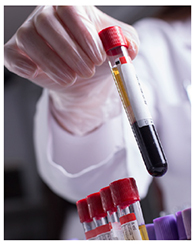 Fibrinogen is a blood protein from which fibrin clots are formed upon blood coagulation or thrombotic process. Fibrinogen consists of two identical subunits that contain three polypeptide chains: α, β, and γ. During blood coagulation fibrinogen is first converted into fibrin by thrombin, and these fibrin monomers then polymerize to form fibrin clots. In fibrinolysis, the fibrin clots are digested by plasmin, and fibrin degradation products (FDP) of different molecular weights are released into the bloodstream (Fig. 1).
Fibrinogen is a blood protein from which fibrin clots are formed upon blood coagulation or thrombotic process. Fibrinogen consists of two identical subunits that contain three polypeptide chains: α, β, and γ. During blood coagulation fibrinogen is first converted into fibrin by thrombin, and these fibrin monomers then polymerize to form fibrin clots. In fibrinolysis, the fibrin clots are digested by plasmin, and fibrin degradation products (FDP) of different molecular weights are released into the bloodstream (Fig. 1).
D-dimer (MW 180 kDa) is the final product of fibrin degradation. It consists of the remnants of all three chains (α, β and γ chains) of fibrinogen cross linked by disulfide bonds. The dimeric structure of D-dimer is held by two covalent, intermolecular isopeptide bonds between the γ-chains.
D-dimer in diagnostics
D-dimer levels in healthy individuals are less than 0.5 μg/ml. Elevated levels of D-dimer have been found in the blood of patients with pulmonary embolism (PE), deep vein thrombosis (DVT) and atherosclerosis. The elevated level of D-dimer in blood is believed to be a reliable marker of pathological coagulation that underlies the pathogenesis of most cardiovascular diseases (1, 2). It is widely used to exclude the diagnosis of deep vein thrombosis (3).
Despite the long history of using the D-dimer test in clinical practice, there are a lot of problems concerning the quantitative determination of D-dimer in plasma samples. A patient’s plasma contains a wide spectrum of FDP of different sizes along with D-dimer itself. All of these products possess the “D-dimer antigen epitope”. Therefore, antibodies specific to D-dimer also recognize FDP. However, there is a great variance between the results obtained by different assays. This can be explained by differences in antibody specificities; some antibodies and antibody pairs recognize D-dimer better than FDP and vice versa. So far all standardization and harmonization attempts have not resulted in satisfying results and this is a continuous cause of problems in daily practice (4).
FIGURE 1. A scheme of fibrin formation and fibrinolysis.
For an accurate determination of all FDP and D-dimer, and for using D-dimer as a standard, MAbs should detect FDP and D-dimer with equal specificity. In addition, assays for D-dimer must not detect fibrinogen whose concentration in plasma is 1000 times higher than that of D-dimer.
Assay development and pair recommendations
For development of D-dimer assays, we provide several monoclonal antibodies specific for D-dimer and FDP. The recommended capture-detection pairs for sandwich immunoassays are shown in Table 1. In addition to antibodies, we offer D-dimer that is produced from clotted fibrinogen by means of plasmin digestion.
Hytest has been one of the world’s leading suppliers of D-dimer antigens for more than 10 years. We offer a highly purified D-dimer prepared from human plasma.
FDP and D-dimer, the most degraded form of FDP, appear in human blood as a result of proteolytic degradation of fibrin clots. The ratio of these products is not constant but varies from patient to patient (see Fig. 4). To decrease bias in quantitation of these degradation products, we have developed an assay which recognizes both FDP and D-dimer with equal specificity. This concept could potentially be one step forward in the attempt to achieve D-dimer assay standardization.
A quantitative sandwich immunoassay that is equally specific for D-dimer and FDP
Hytest offers new MAbs (DD189 and DD255) that recognize D-dimer and high molecular weight fibrin degradation products with equal specificity in a sandwich FIA up to 1 μg/ml antigen concentration (Fig. 3). To be analyzed in a sandwich immunoassay, plasma can be diluted ten-fold with 20 mM Tris-HCl buffer, pH 7.5, containing 0.15 M NaCl.
Both MAbs stained D-dimer in Western blotting under reducing and non-reducing conditions (Fig. 6 A and B).
The development and characterization of these MAbs is described in the article by Kogan et al. (5).
The ratio of D-dimer and FDP varies between patients
We analyzed plasma from patients with two different disorders using gel filtration. The results show that the ratio of D-dimer and FDP is not constant (Fig. 4). This finding further supports the idea that an immunoassay should equally recognize D-dimer and FDP to allow for a more accurate determination of all products resulting from fibrin degradation.
Antibody recommendations for quantitative sandwich immunoassays
The recommended pairs are listed in Table 1. They are specific to cross-linked material (D-dimer and high molecular weight fibrin degradation products) in samples and do not detect fibrinogen (Fig. 5).
* Due to the cross-reactivity of DD4 with fibrinogen, we
strongly recommend to use it as the detection antibody. In a sandwich immunoassay, plasma must be diluted at least two-fold with 10 mM Tris-HCl, pH 7.5, 1 M NaCl, 0.1 % Tween 20 in order to avoid nonspecific binding. Each step in the assay should be followed by an incubation and wash: coating with the capture MAb, addition of the sample and addition of the (conjugated) detection MAb.
Anti-D-dimer MAbs can be used in Western blotting
Anti-D-dimer antibodies can be used in Western blotting to detect D-dimer. All MAbs stained nonreduced D-dimer and some of them stained reduced D-dimer as well (Fig. 6 A and B, respectively).
See other Cardiac markers and blood coagulation products
See HyTest articles.
Search D-dimer references from PubMed.